Study on Structural Parameters and Analysis Method of Soil Successive Impulse Discharge Channel †
Abstract
1. Introduction
2. Experimental Platform and Analysis Method
2.1. Experimental Platform
2.2. Extraction Method of Discharge Channel Volume
3. The Structure Changing Rule of Successive Impulse Discharge Channel
3.1. Influence of Current
3.2. Influence of Soil Properties
4. Analysis Method Considering Discharge Channel Structure
4.1. Basic of Model
- The resistivity of soil in the arc discharge channel is the product of initial soil resistivity and the attenuation coefficient.
- When the electric field strength is greater than the critical breakdown electric field strength (E > EC), the resistivity of the soil is much lower than the initial resistivity, but the reduction degree is much lower than that of the soil inside the arc channel.
- When the electric field strength is less than the critical breakdown electric field strength (E ˂ EC), the soil resistivity changes nonlinearly, and decreases exponentially with the increase of electric field intensity, and the attenuation degree is smaller than that of the ionization zone.
- When the electric field intensity is small and can be ignored, the soil resistivity is the initial value.
- The soil resistivity in the arc discharge channel can be determined according to the experimental results in literature [2,20]. The residual resistivity can be obtained by iterative calculation when it is first broken down by impulse current [2]. When the second breakdown occurs, the residual resistivity is the product of the calculated value of the first breakdown and the recovery coefficient [20].
- The soil residual resistivity in the ionization zone has been studied in the literature [28,29,30], and the results show that the residual resistivity is distributed between 1.7% and 50% of the initial resistivity. For example, when the initial soil resistivity is about 50 Ωm, the residual resistivity of the ionization zone is about 10–20% of the initial value [28,29,30]. However, because the arc channel and ionization zone are not distinguished in the above test analysis, the larger value in the range is selected in this paper.
- The experimental results for the relationship between soil resistivity and electric field in the nonlinear zone are given in literature [31]. Although the results of different organizations are varied, their change trend and value range are basically consistent. Before reaching the critical breakdown field strength, the soil resistivity decreases exponentially with the increase of electric field strength, and the value range of the reduction coefficient is basically decreased from 1 to about 0.5 [31].
- The soil resistivity in the constant conductivity zone can be considered to maintain the initial value unchanged. In this paper, the space coordinate transformation method is used to represent the infinite earth environment.
4.2. Numerical Analysis Method
4.3. Basic Case Analysis
4.4. Discharge Channel Structure
5. Conclusions
Author Contributions
Funding
Institutional Review Board Statement
Informed Consent Statement
Data Availability Statement
Acknowledgments
Conflicts of Interest
Nomenclature
| Symbol/Abbreviation | Definition | Unit |
| SGS | standard gray sandbox | / |
| DS | discharge sandbox | / |
| GRGD | growth rate of gray difference | / |
| GPR | Ground potential rise | / |
| Gn | the matrix of gray image before the discharge channel is generated | / |
| Gd | the matrix of gray image after the discharge channel is generated | / |
| Gc′ | Grayscale difference matrix caused by discharge channel and background error | / |
| Gc | Grayscale difference matrix caused by discharge channel | / |
| G0 | Background error constant matrix | / |
| hc(ij) | Thickness of discharge channel at each pixel | cm |
| a | GRGD (growth rate of gray difference) | / |
| sc(ij) | The area corresponding to each pixel | cm2 |
| Vc | Discharge channel volume | cm3 |
| Ec | Critical breakdown field strength | kV/m |
| ρ0 | Initial soil resistivity | Ωm |
| ρres_1 | Residual resistivity of soil after first breakdown | Ωm |
| ρres_2 | Residual resistivity of soil after second breakdown | Ωm |
| φ | Potential | V |
| E | Electric field intensity | kV/m |
| D | Electric flux density | C/m2 |
| J | Total current density | A/m2 |
| Jc | Conduction current density | A/m2 |
| Jd | Displacement current density. | A/m2 |
References
- Sima, W.X.; Liu, S.W.; Yuan, T.; Luo, D.H.; Wu, P.; Zhu, B. Experimental study of the discharge area of soil breakdown under surge current using X-ray imaging technology. IEEE Trans. Ind. Appl. 2015, 51, 5343–5351. [Google Scholar] [CrossRef]
- Liu, S.W.; Sima, W.X.; Yuan, T.; Luo, D.H.; Bai, Y.; Yang, M. Study on X-ray imaging of soil discharge and calculation method of the ionization parameters. IEEE Trans. Power Deliv. 2017, 32, 2013–2021. [Google Scholar] [CrossRef]
- Androvitsaneas, V.P.; Damianaki, K.D.; Christodoulou, C.A.; Gonos, I.F. Effect of soil resistivity measurement on the safe design of grounding systems. Energies 2020, 13, 3170. [Google Scholar] [CrossRef]
- Ala, G.; Favuzza, S.; Francomano, E.; Giglia, G.; Zizzo, G. On the distribution of lightning current among interconnected grounding systems in medium voltage grids. Energies 2018, 11, 771. [Google Scholar] [CrossRef]
- Steinsland, V.; Sivertsen, L.H.; Cimpan, E.; Zhang, S.J. A new approach to include complex grounding system in lightning transient studies and EMI evaluations. Energies 2019, 12, 3142. [Google Scholar] [CrossRef]
- Zhang, B.; Li, Z.Z.; Wang, S. Onset electric field of soil ionisation around grounding electrode under lightning. High Volt. 2020, 5, 614–619. [Google Scholar] [CrossRef]
- Luo, D.H.; Cao, Y.X.; Sima, W.X.; Yuan, T.; Xie, S.J.; Zhang, Y. Study on changing law of 3D structure of successive impulse discharge channel in the ground. In Proceedings of the 2020 IEEE International Conference on High-Voltage Engineering (ICHVE 2020), Beijing, China, 6–10 September 2020. [Google Scholar]
- Reffin, M.S.; Nor, N.M.; Ahmad, N.N.; Abdullah, S. Performance of practical grounding systems under high impulse conditions. Energies 2018, 11, 3187. [Google Scholar] [CrossRef]
- Fakhraei, M.; Mahmoudian, M.; Rodrigues, E.M.G. Grounding system modeling and evaluation using integrated circuit based fast relaxed vector fitting approach considering soil ionization. Appl. Sci. 2020, 10, 5632. [Google Scholar] [CrossRef]
- Moreno, J.; Simon, P.; Faleiro, E.; Asensio, G.; Fernandez, J.A. Estimation of an upper bound to the value of the step potentials in two-layered soils from grounding resistance measurements. Materials 2020, 13, 290. [Google Scholar] [CrossRef] [PubMed]
- Ali, A.W.A.; Ahmad, N.N.; Nor, N.M.; Reffifin, M.S.; Abdullah, S.A.S. Investigations on the performance of a new grounding device with spike rods under high magnitude current conditions. Energies 2019, 12, 1138. [Google Scholar]
- Zhang, B.P.; He, J.L.; Zeng, R. Spatially discontinuous ionization phenomenon in inhomogeneous soil. Sci. China Technol. Sci. 2010, 53, 918–921. [Google Scholar] [CrossRef]
- Wen, X.S.; Feng, Z.Q.; Lu, H.L.; Tong, X.F.; Lan, L.; Chen, W.G.; Tan, B. Sparkover observation and analysis of the soil under the impulse current. IET Sci. Meas. Technol. 2016, 10, 228–233. [Google Scholar] [CrossRef]
- Cabrera, V.M.; Cooray, V. On the mechanism of space charge generation and neutralization in a coaxial cylindrical configuration in air. J. Electrost. 1992, 28, 187–196. [Google Scholar] [CrossRef]
- Victor, M.; Cabrera, M.; Lundquist, S.; Cooray, V. On the physical properties of discharges in sand under lightning impulses. J. Electrost. 1993, 30, 17–28. [Google Scholar] [CrossRef]
- Wang, J.; Liew, A.C.; Darveniza, M. Extension of dynamic model of impulse behavior of concentrated grounds at high currents. IEEE Trans. Power Deliv. 2005, 20, 2160–2165. [Google Scholar] [CrossRef]
- Elzowawi, A.; Haddad, A.; Griffiths, H. Visualization of electric discharge in porous materials. In Proceedings of the International Conference on High Voltage Engineering and Application (ICHVE), Poznan, Poland, 8–11 September 2014. [Google Scholar]
- Rakov, V.A. Triggered Lightning; Springer: Berlin, Germany, 2009. [Google Scholar]
- Rakov, V.A.; Uman, M.A. Lightning: Physics and Effects; Cambridge University Press: New York, NY, USA, 2003. [Google Scholar]
- Luo, D.H.; Sima, W.X.; Yuan, T.; Sun, P.T.; Chen, W.; Wang, J. Influence-factor analysis and parameter calculation of soil discharge and recovery characteristics under successive impulse currents. IEEE Trans. Power Deliv. 2019, 34, 514–523. [Google Scholar] [CrossRef]
- Sima, W.X.; Luo, D.H.; Yuan, T.; Liu, S.W.; Sun, P.T.; Li, T.X. Study on the image observation method and characteristics of soil discharge process under multiple impulse currents. IEEE Trans. Power Deliv. 2018, 33, 2125–2134. [Google Scholar] [CrossRef]
- Petropoulos, G.M. The high-voltage characteristics of earth resistances. J. Inst. Electr. Eng. Part II Power Eng. 1948, 95, 59–70. [Google Scholar]
- Bellaschi, P.L.; Armington, R.E. Impulse and 60-cycle characteristics of driven grounds—III effect of lead in ground installation. Electr. Eng. 1943, 62, 334–345. [Google Scholar] [CrossRef]
- Bellaschi, P.L. Impulse and 60-cycle characteristics of driven grounds. Electr. Eng. 1941, 60, 123–128. [Google Scholar] [CrossRef]
- Velazquez, R.; Mukhedkar, D. Analytical modelling of grounding electrodes transient behavior. IEEE Trans. Power Appar. Syst. 1984, 103, 1314–1322. [Google Scholar] [CrossRef]
- Li, J.L.; Yuan, T.; Yang, Q.; Sima, W.X.; Sun, C.X.; Zahn, M. Numerical and experimental investigation of grounding electrode impulse-current dispersal regularity considering the transient ionization phenomenon. IEEE Trans. Power Deliv. 2011, 26, 2647–2658. [Google Scholar] [CrossRef]
- Luo, D.H.; Yuan, T.; Sima, W.X.; Cao, Y.X.; Ye, S.Y.; Yao, X.Y. Study on the process of soil recovery and method of volume parameter extraction of branch discharge channel under successive impulse currents. High Volt. Tech. 2020, 46, 1791–1799. [Google Scholar]
- Liu, Y.Q.; Theethayi, N.; Gonzalez, R.M.; Thottappillil, R. The residual resistivity in soil ionization region around grounding system for different experimental results. In Proceedings of the IEEE Symposium on Electromagnetic Compatibility, Boston, MA, USA, 18–22 August 2003. [Google Scholar]
- Bellaschi, P.L.; Arminggton, R.E.; Snowden, A.E. Impulse and 60-cycle characteristics of driven grounds II. AIEE Trans. 1942, 61, 349–363. [Google Scholar]
- Liew, A.C.; Darveniza, M. Dynamic model of impulse characteristics of concentrated carths. Proc. IEEE 1974, 121, 123–135. [Google Scholar]
- Zhu, B. Study on the Variation Characteristics of Soil Electrical Parameters and the Influence on Grounding Device’s Performance. Ph.D. Thesis, Chongqing University, Chongqing, China, 2015. [Google Scholar]
- Geri, A. Behaviour of grounding systems excited by high impulse currents: The model and its validation. IEEE Trans. Power Deliv. 1999, 14, 1008–1017. [Google Scholar] [CrossRef]
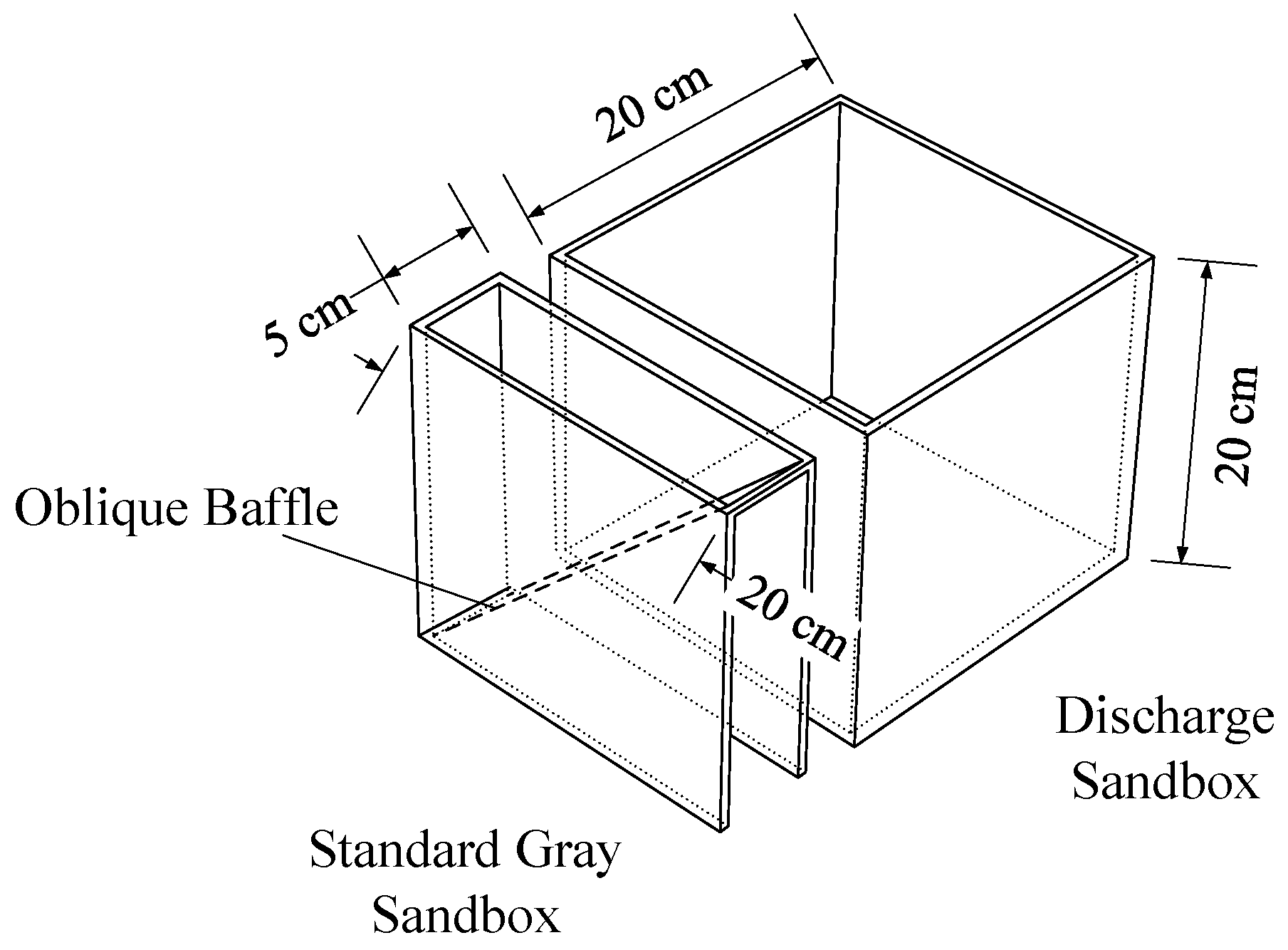
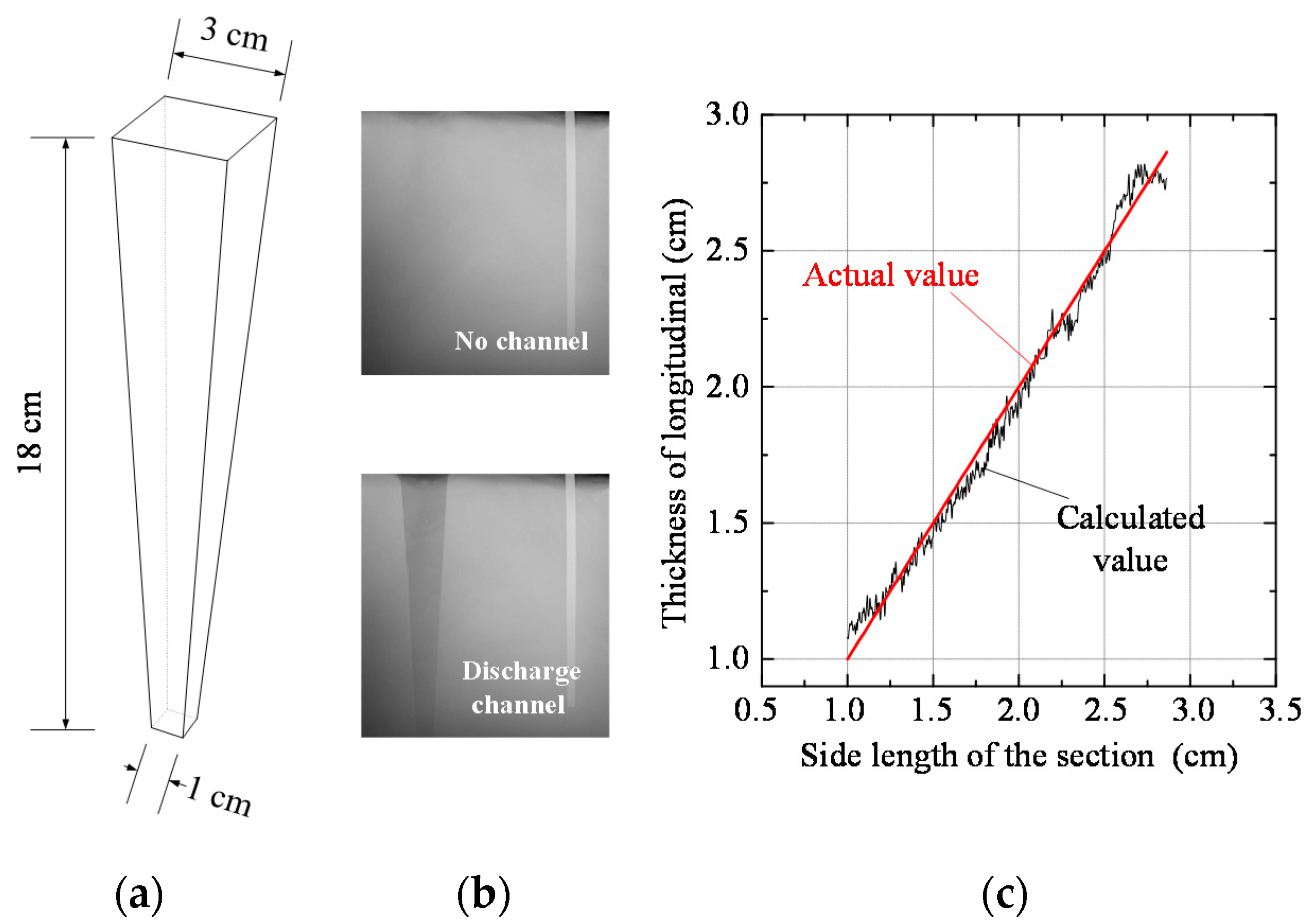


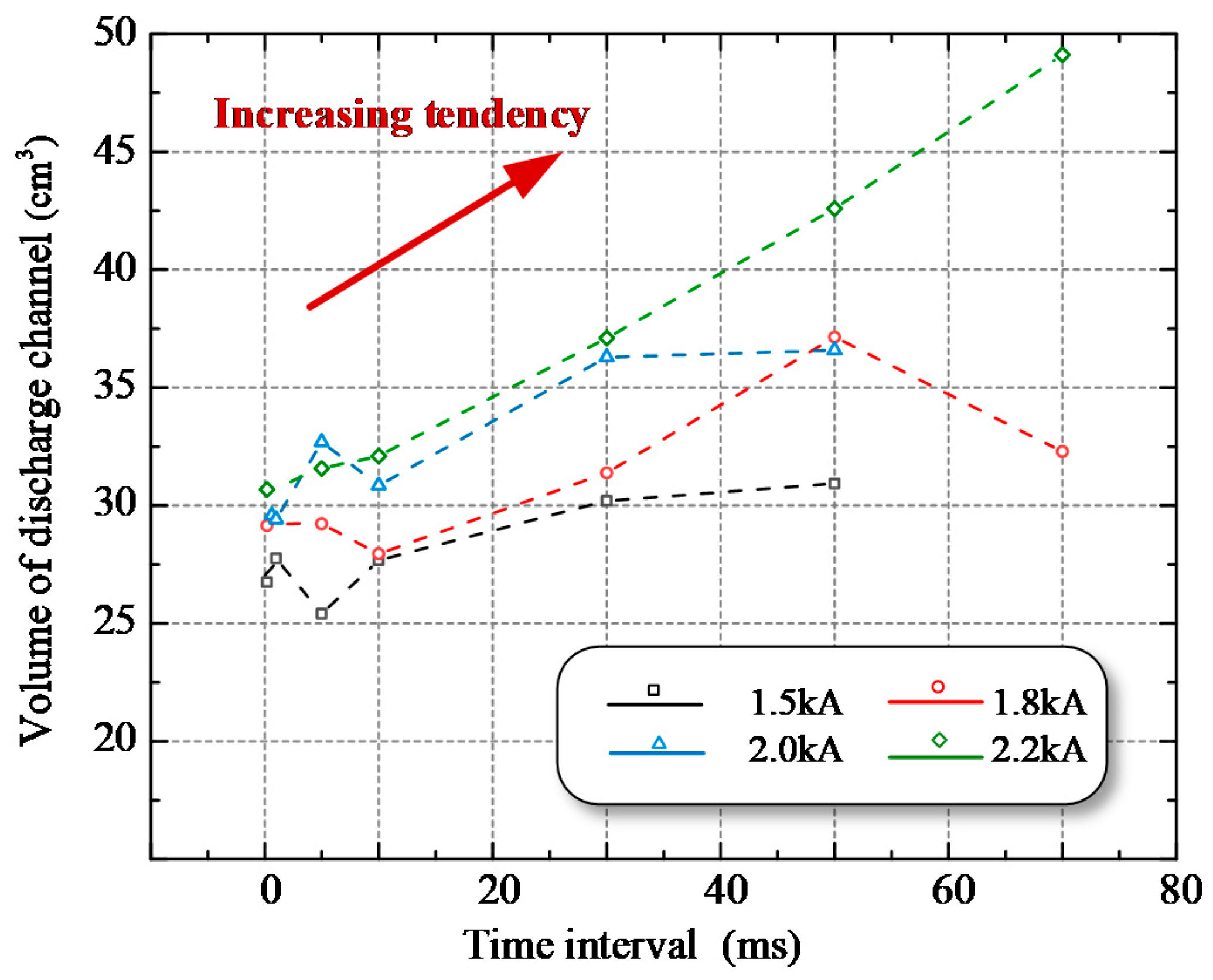
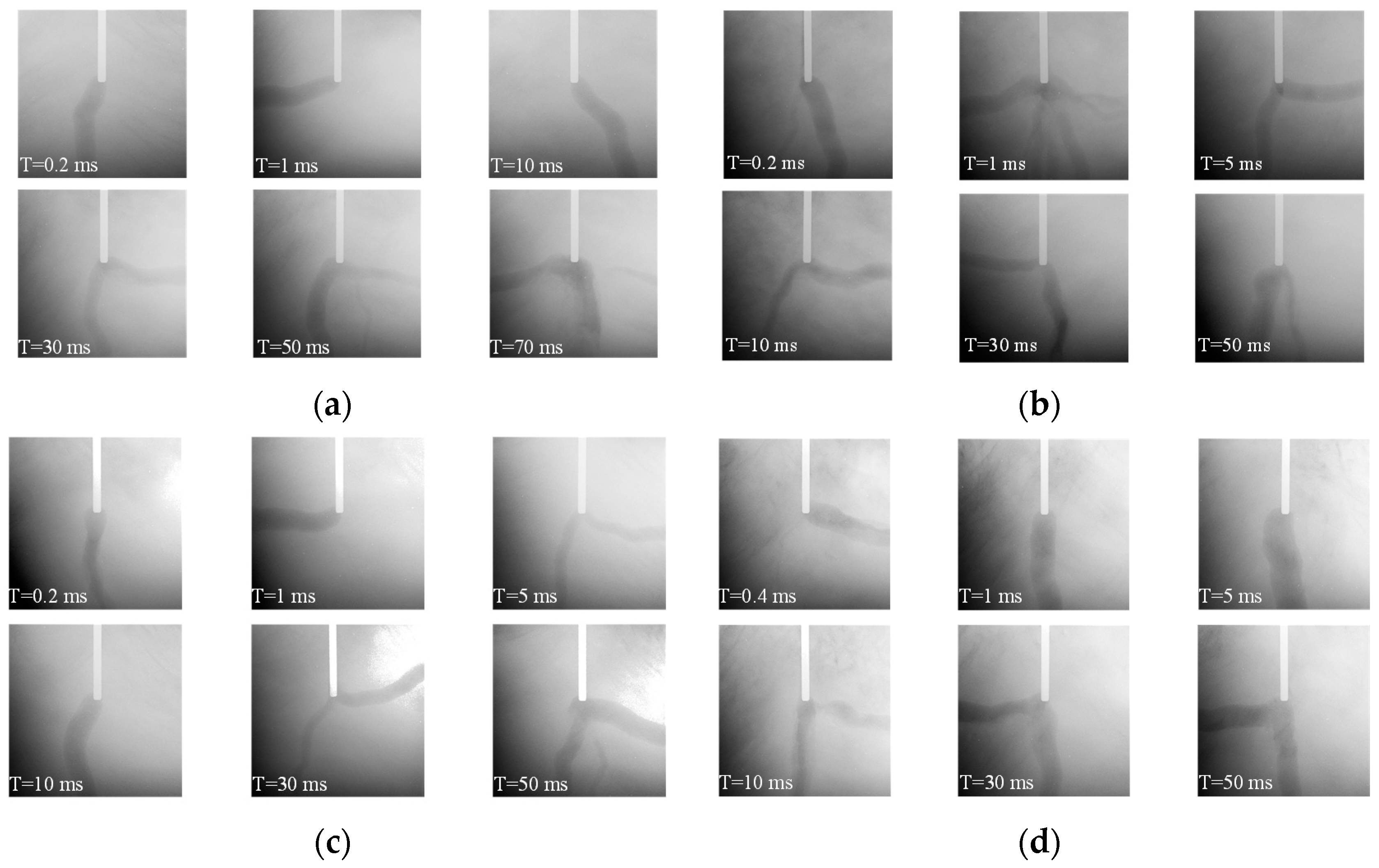
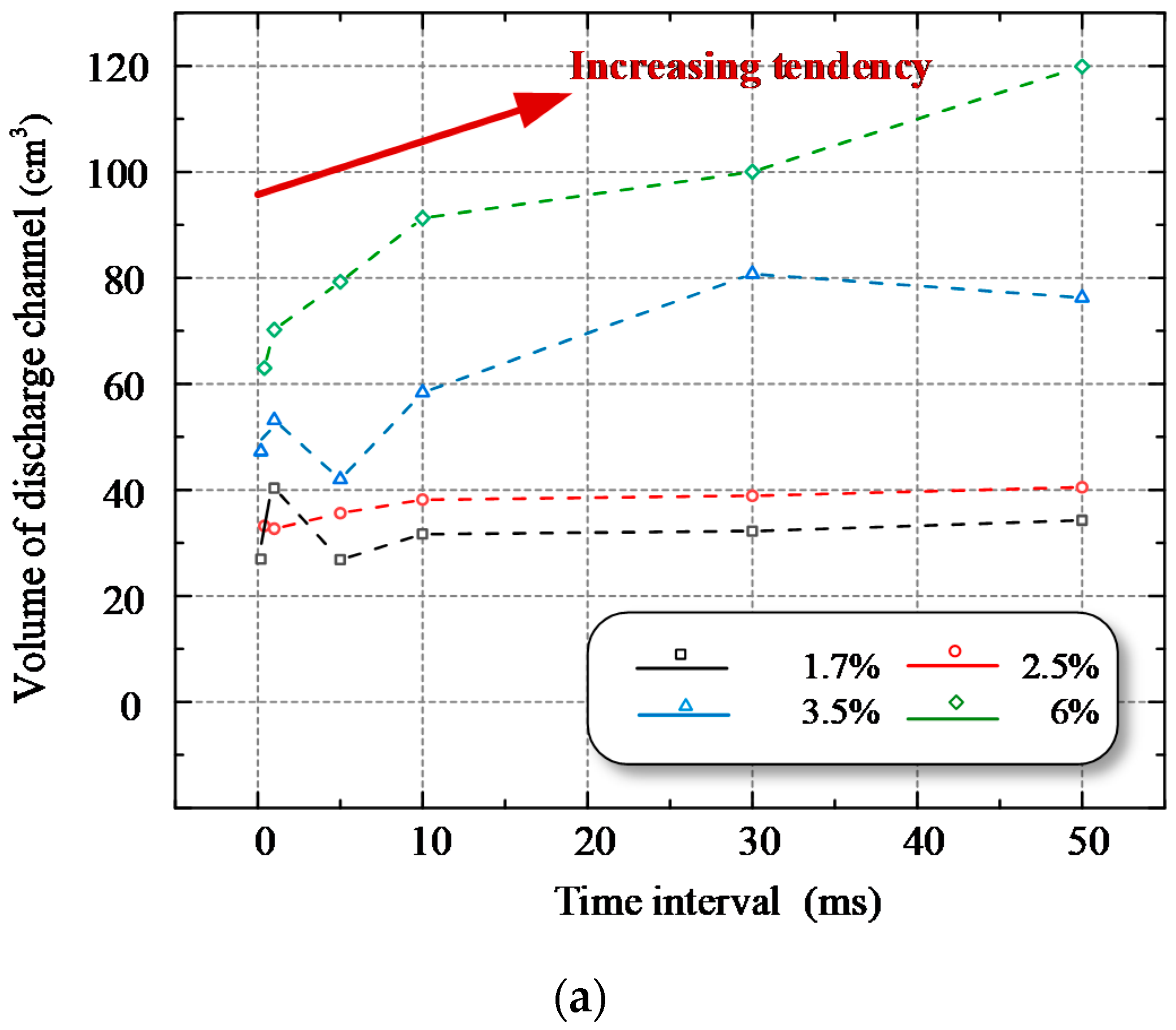
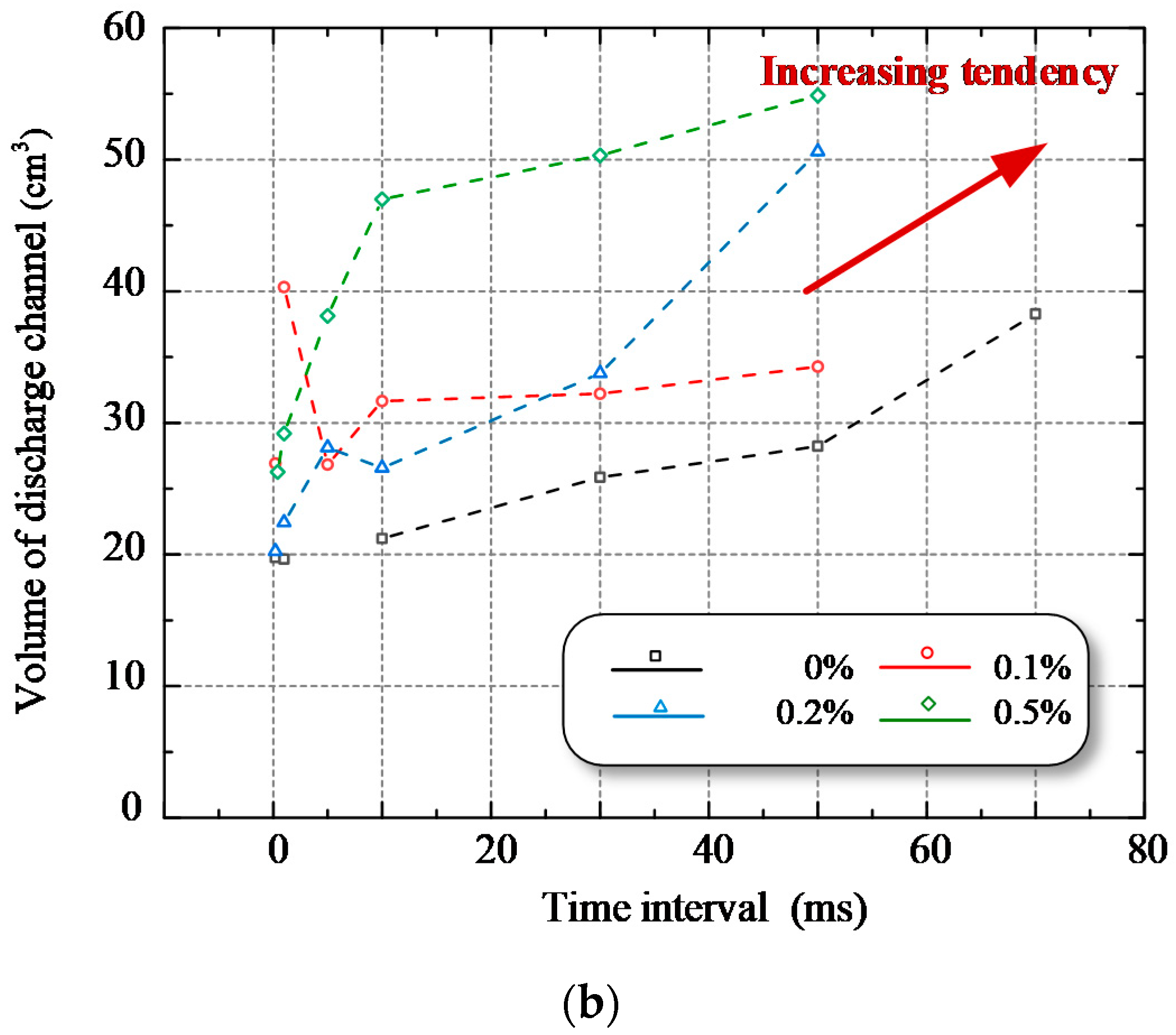
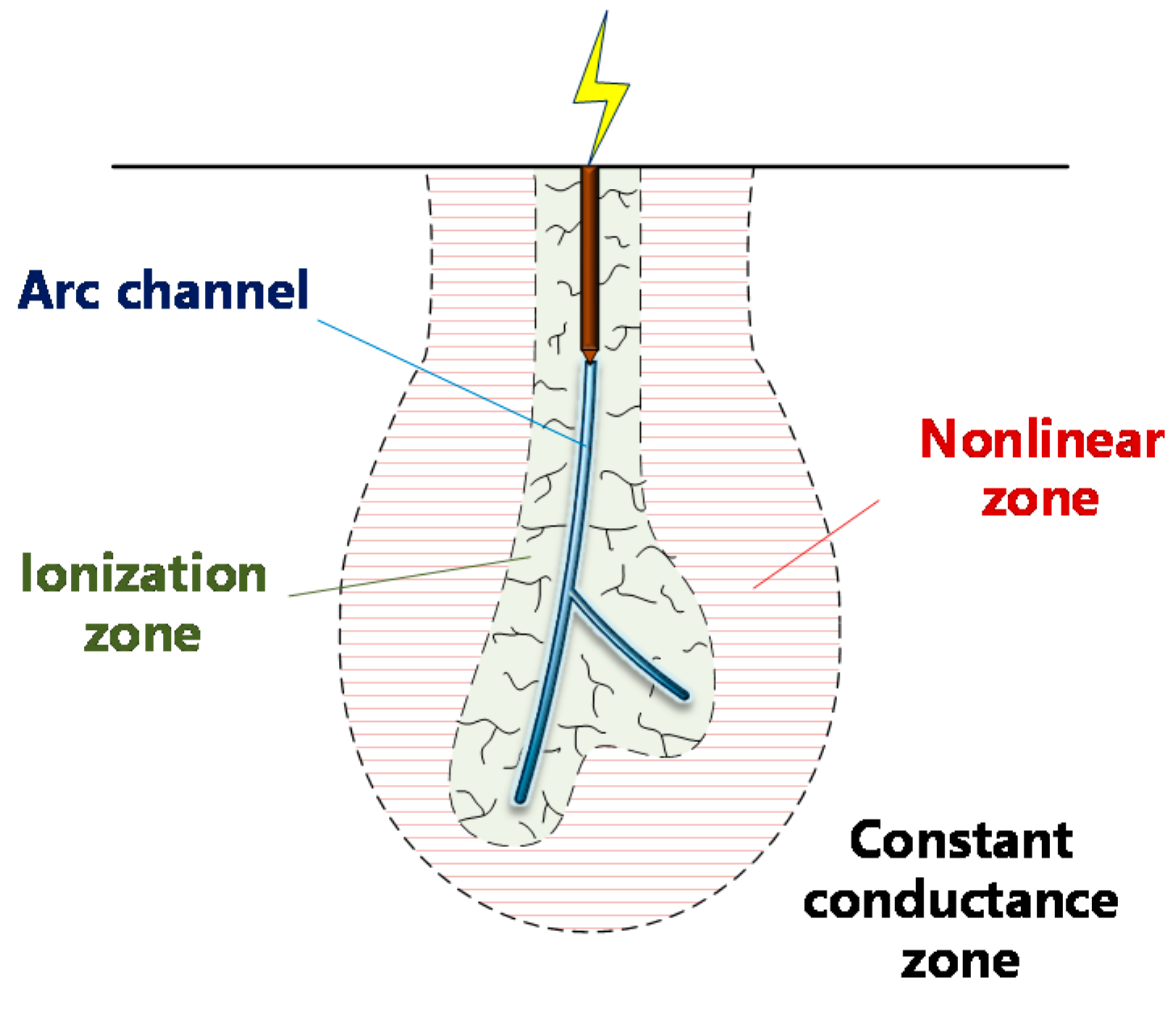
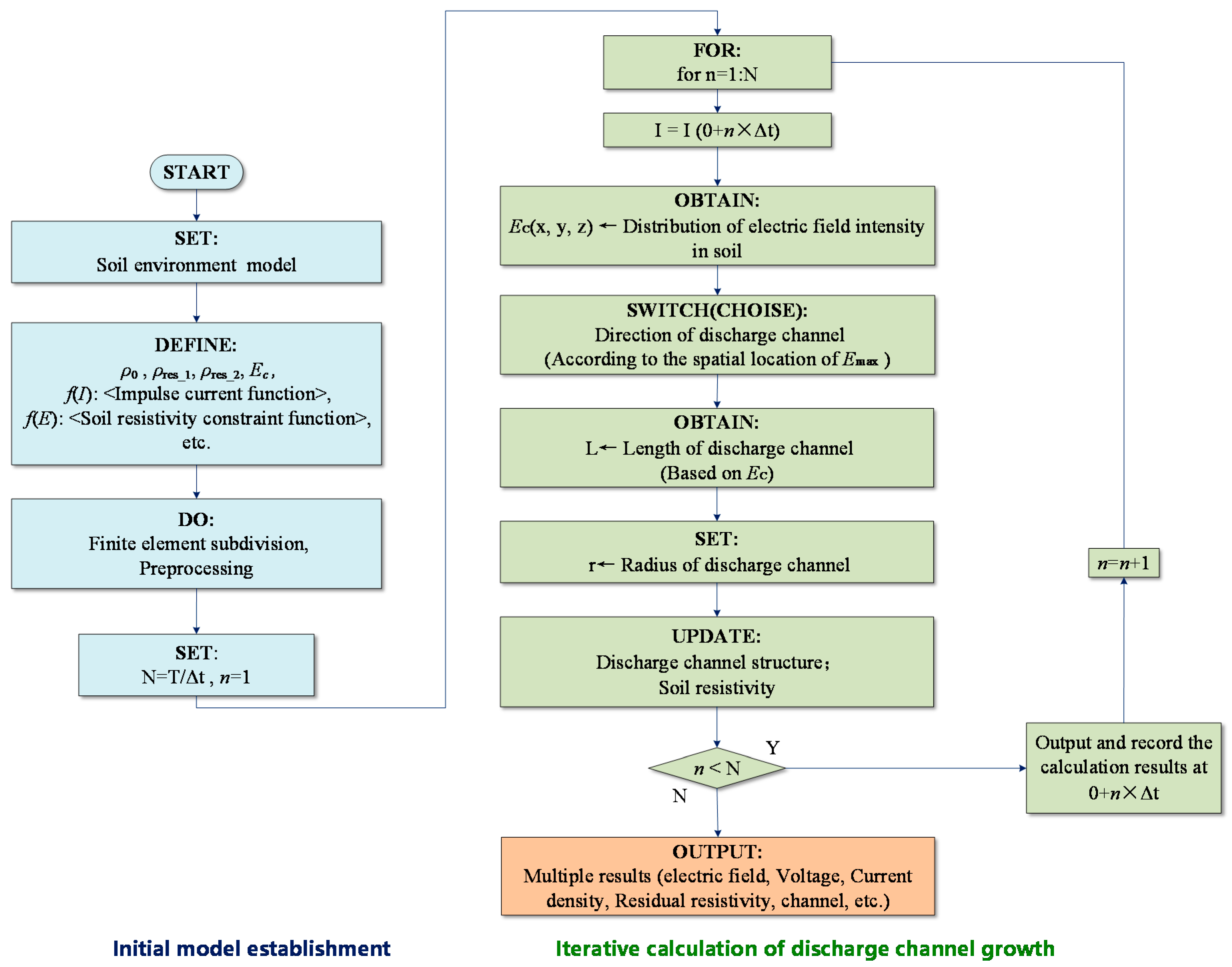
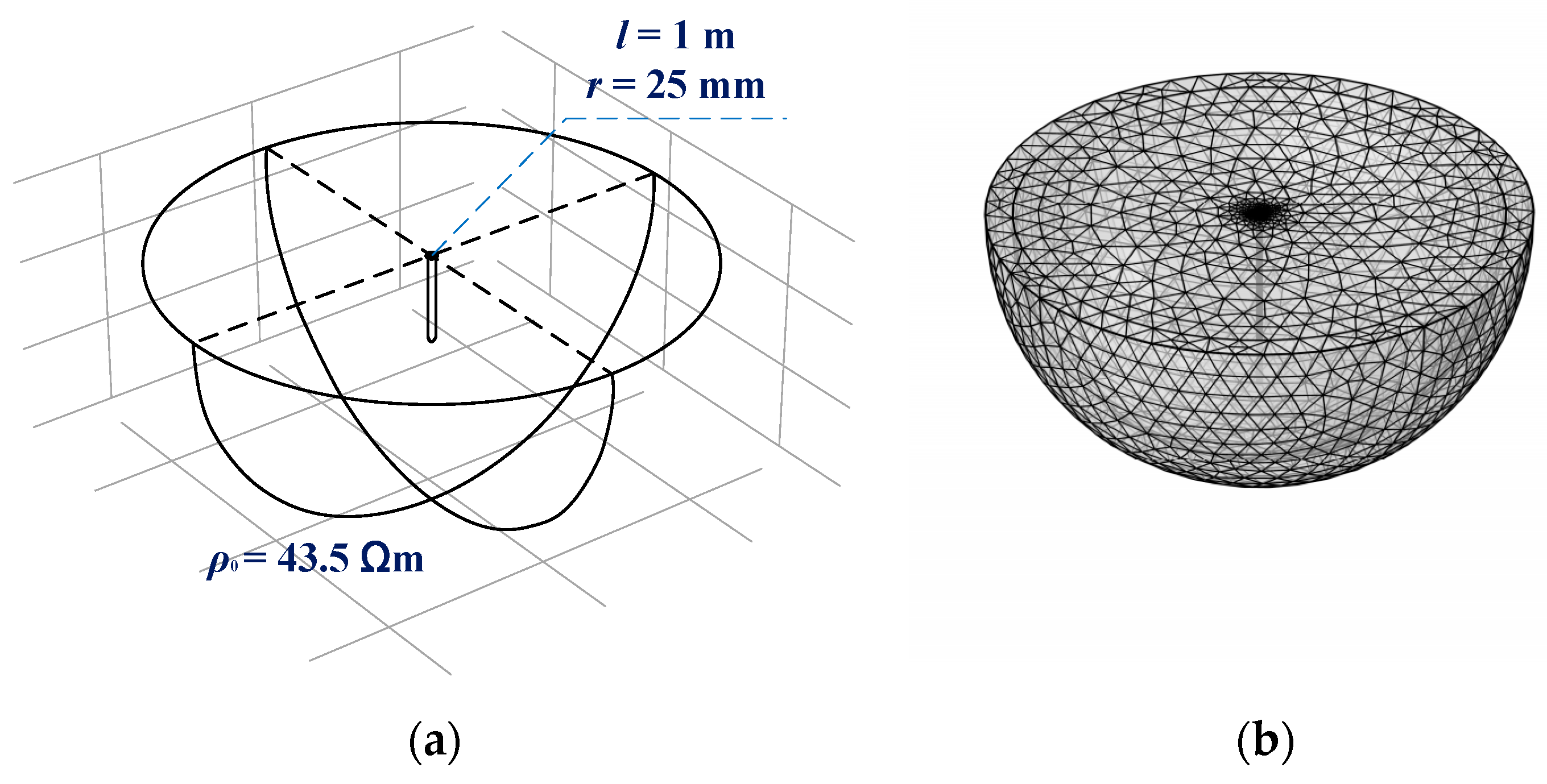
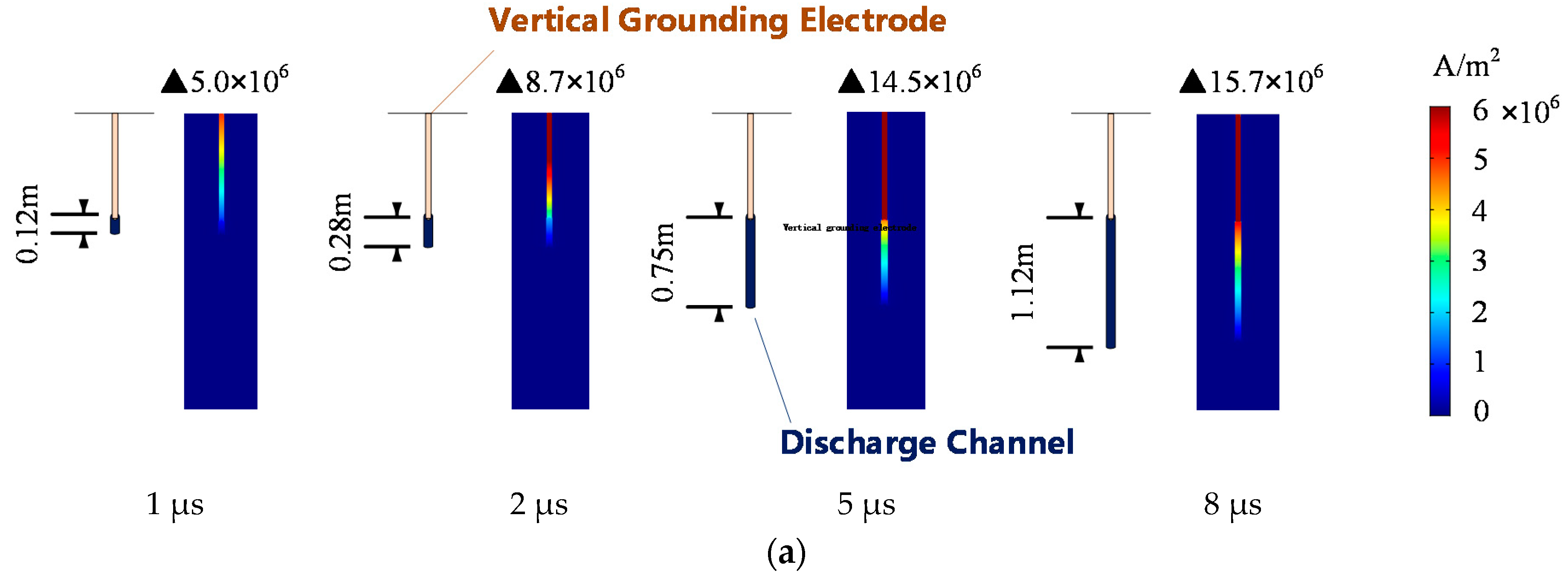
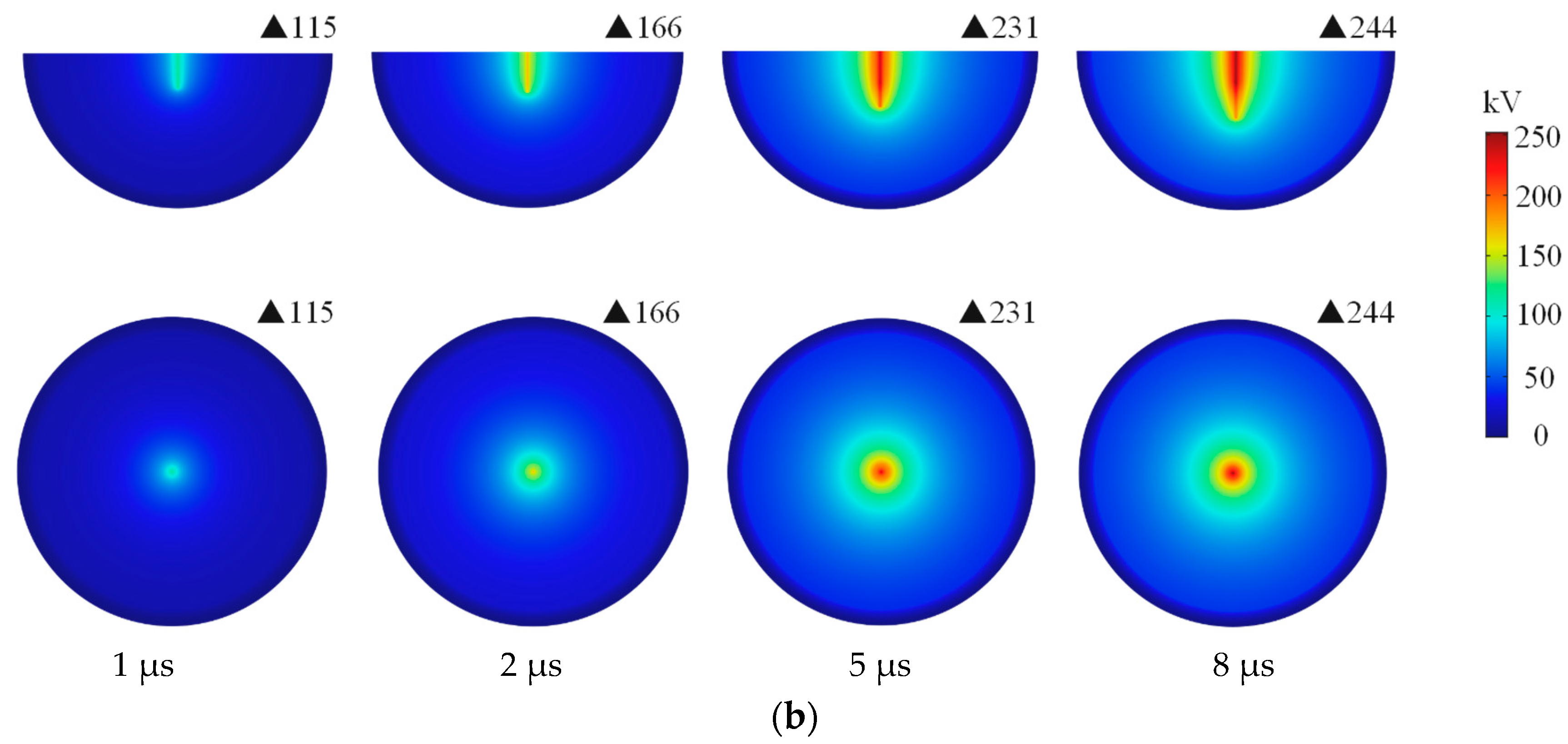
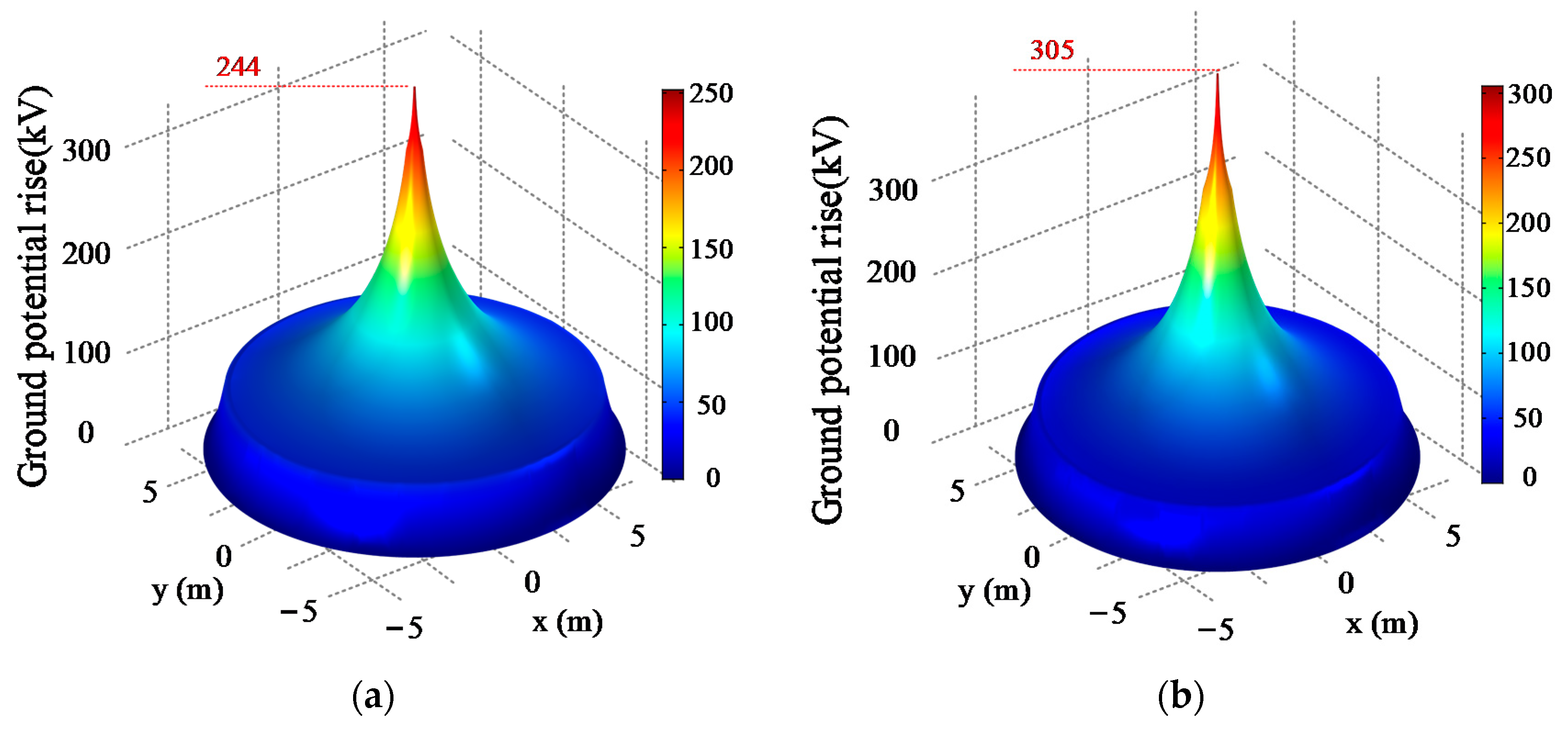
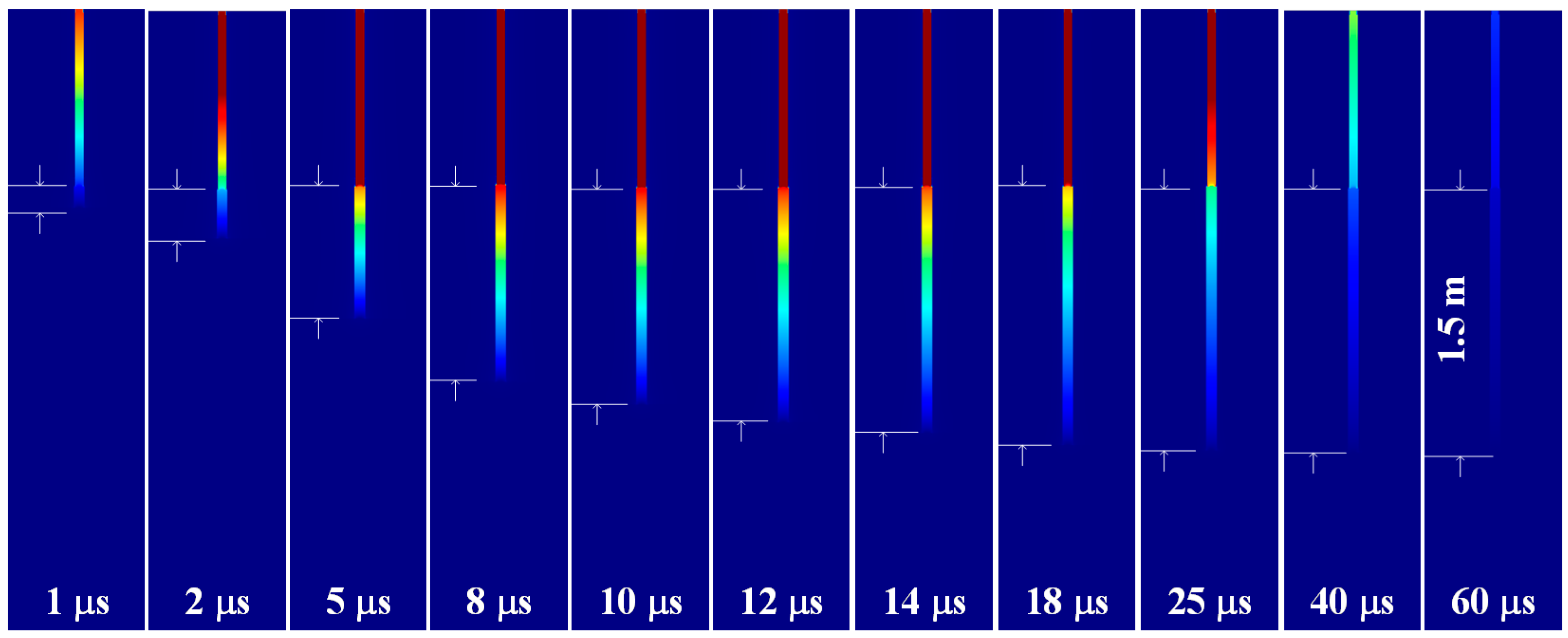
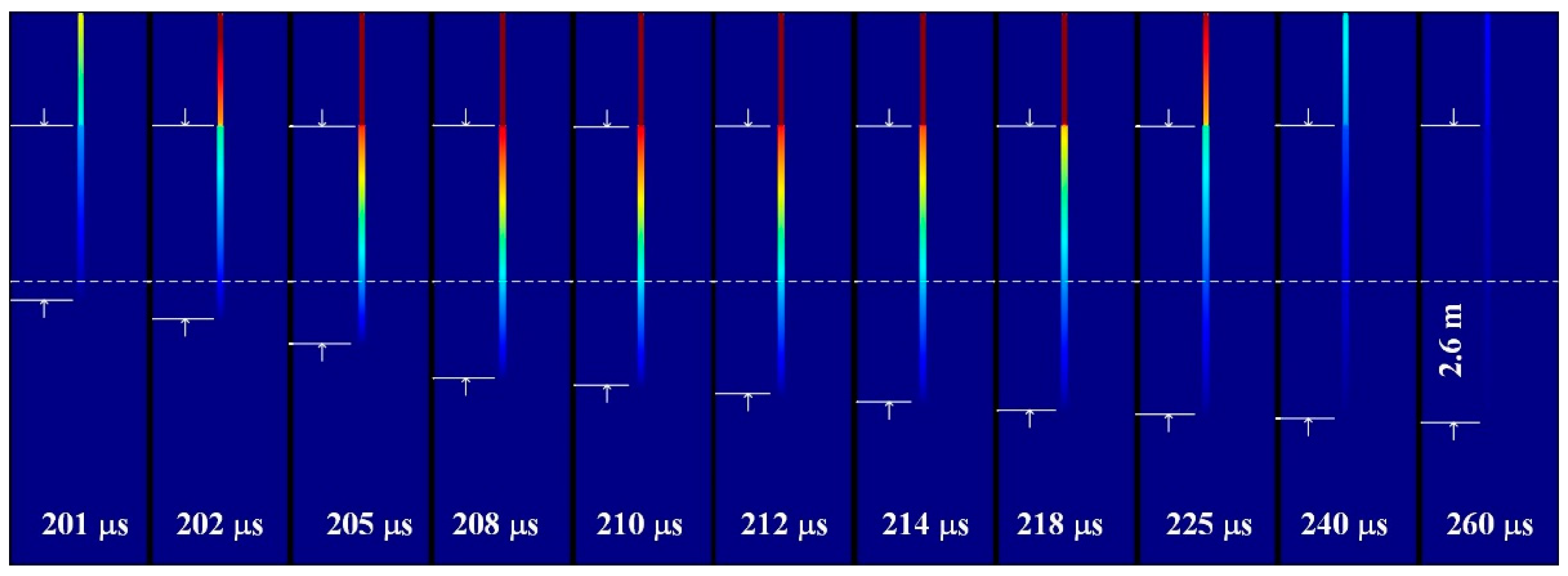
| Imax (kA) | Ri (Ω) | GPR (kV) | ||
|---|---|---|---|---|
| Experiment | Model | Experiment | Model | |
| 30.8 | 8.1 | 7.9 | 248 | 244 |
Publisher’s Note: MDPI stays neutral with regard to jurisdictional claims in published maps and institutional affiliations. |
© 2021 by the authors. Licensee MDPI, Basel, Switzerland. This article is an open access article distributed under the terms and conditions of the Creative Commons Attribution (CC BY) license (http://creativecommons.org/licenses/by/4.0/).
Share and Cite
Luo, D.; Cao, Y.; Zhang, Y.; Xie, S.; Zhang, C.; Cao, S. Study on Structural Parameters and Analysis Method of Soil Successive Impulse Discharge Channel. Energies 2021, 14, 877. https://doi.org/10.3390/en14040877
Luo D, Cao Y, Zhang Y, Xie S, Zhang C, Cao S. Study on Structural Parameters and Analysis Method of Soil Successive Impulse Discharge Channel. Energies. 2021; 14(4):877. https://doi.org/10.3390/en14040877
Chicago/Turabian StyleLuo, Donghui, Yongxing Cao, Yu Zhang, Shijun Xie, Chenmeng Zhang, and Shuping Cao. 2021. "Study on Structural Parameters and Analysis Method of Soil Successive Impulse Discharge Channel" Energies 14, no. 4: 877. https://doi.org/10.3390/en14040877
APA StyleLuo, D., Cao, Y., Zhang, Y., Xie, S., Zhang, C., & Cao, S. (2021). Study on Structural Parameters and Analysis Method of Soil Successive Impulse Discharge Channel. Energies, 14(4), 877. https://doi.org/10.3390/en14040877






